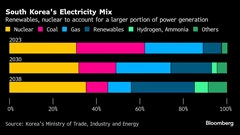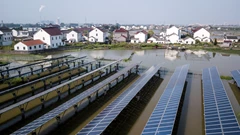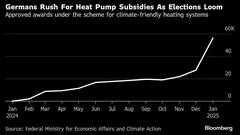Global Emissions Likely Have Peaked as Renewables Take Hold
(Bloomberg) -- The world is choking from emissions more than ever but that trend is set to reverse starting next year as the cost of solar panels and batteries crowd out coal and stunt the growth of oil, a new report says.
DNV, a Norwegian risk management company, finds global emissions likely have peaked, but the transition to clean energy remains “too slow.”
“Worryingly, our forecasted decline is very far from the trajectory required to meet the Paris Agreement targets,” DNV Chief Executive Officer Remi Eriksen wrote in the report. “In particular, the hard-to-electrify sectors need a renewed policy push.”

Though renewable growth continues to beat records, some countries continue to struggle, the report said. More military spending and tough economic conditions mean nations are sometimes turning away from ambitious climate goals.
“There is a growing mismatch between short-term geopolitical and economic priorities versus the need to accelerate the energy transition,” Eriksen added.
The cost of deploying solar panels and battery technology is due to drop by 19% by 2030, helping deliver record amounts of low carbon power, DNV predicts. A separate report from the International Energy Agency estimates an increase in solar capacity will account for 80% of renewable power growth globally until the end of the decade.
Overall, renewables are due to grow 2.2 times by 2030, well below the tripling set out during the COP28 United Nations Climate Change Conference, DNV said. Similarly, energy efficiency improvements are taking place at about half the rate recommended by the UN’s climate body.
DNV lowered its 2050 forecast for offshore wind power by 18%, the second year it cut expectations. Higher financing costs, supply chain issues and turbine quality concerns are to blame, it said. These issues are causing investors and developers to shift capital toward solar, which is able to leverage faster timelines, according to the IEA.
By 2027, solar generation will overtake wind power as the biggest source of renewable energy, the IEA said.
“Renewables are moving faster than national governments can set targets for,” Fatih Birol, IEA executive director, said in a statement. “It’s increasingly because renewables today offer the cheapest option to add new power plants in almost all countries around the world.”

In DNV’s report, hydrogen also saw it’s outlook downgraded 21% from last year’s estimate. The clean fuel is now set to provide 1.5% of global energy by 2040, down from the 2.6% set out last year. The high cost of hydrogen and the lack of price visibility on carbon is a major challenge for the sector, according to DNV. And carbon capture technology is not expected to be a huge contributor to emissions reductions for similar reasons, DNV said.
Listen on Zero: Colombia Is Quitting Fossil Fuels. Can It Convince Other Countries?
(Updates with details from IEA report starting with the sixth paragraph.)
©2024 Bloomberg L.P.
KEEPING THE ENERGY INDUSTRY CONNECTED
Subscribe to our newsletter and get the best of Energy Connects directly to your inbox each week.
By subscribing, you agree to the processing of your personal data by dmg events as described in the Privacy Policy.
More renewables news

GB Energy Faces New Doubts as UK Declines to Affirm Future Funds

Korea Cancels Planned Reactor After Impeaching Pro-Nuke Leader

Brazil’s Net-Zero Transition Will Cost $6 Trillion by 2050, BNEF Says

SolarEdge Climbs 40% as Revenue Beat Prompts Short Covering

EU to Set Aside Funds to Protect Undersea Cables from Sabotage

China Revamps Power Market Rules In Challenge to Renewables Boom

KKR increases stake in Enilive with additional €587.5 million investment

TotalEnergies and Air Liquide partner to develop green hydrogen projects in the Netherlands

Germany Set to Scale Down Climate Ambitions
















